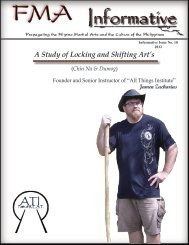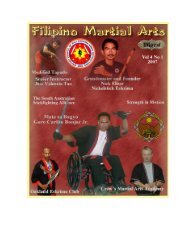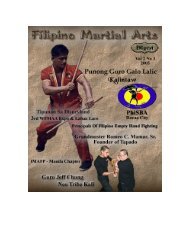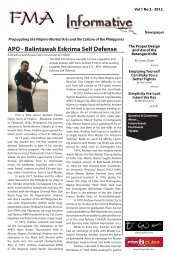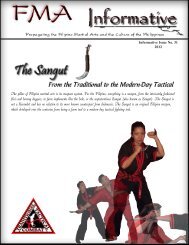Tournaments - FMA Informative
Tournaments - FMA Informative
Tournaments - FMA Informative
Create successful ePaper yourself
Turn your PDF publications into a flip-book with our unique Google optimized e-Paper software.
My training emphasizes controlling longrange<br />
encounters with broken, flowing or<br />
combination strikes, thrown from all angles, in<br />
small numbers. Whether advancing or retreating,<br />
forward pressure is always on. After all, one<br />
doesn’t have to move much to make an attack or<br />
strike of your opponent’s miss. Likewise,<br />
precision strikes are accomplished within a<br />
matter of inches and split second timing.<br />
How do you handle a long-range attack<br />
already set in motion? Does one simply step back<br />
and get out of the way, or bring a stronger attack<br />
to the adversary? Either way, the longer it takes an attack to reach its target, the greater<br />
the likelihood that it will be countered or neutralized. The most effective strikes (or<br />
blocks), therefore, are short compact ones.<br />
How does one train for these conditions? First, you need to focus on developing<br />
non-telegraphic striking. Never pull, wind or chamber the striking hand back. Limit the<br />
movements you make when recovering from one strike to the next.<br />
Second, emphasize mobility in your footwork. Refrain from assuming a fencing<br />
stance, which limits you to forward and backward movements only. Body shifting by<br />
itself, although providing an efficient method of avoiding attacks, nevertheless leaves you<br />
still within striking range for subsequent secondary attacks. With footwork, one not only<br />
avoids the attack but actually improves one’s position and creates advantage.<br />
Finally, mentally eliminate the<br />
distinction between blocking and striking;<br />
they really are one and the same. This holds<br />
true especially in edged weapon<br />
applications. A parry with a knife is<br />
potentially a cut or counterattack.<br />
It has been proven in many times in<br />
combat that the way one practices is the way<br />
one will instinctively fight. Always keep<br />
one’s training realistic and simple. Gross<br />
motor skill, executed with a minimum of<br />
movement and a maximum of force, will<br />
always be superior to the more artful, but less rational, movement’s common to and<br />
emphasized in some Filipino martial art systems.<br />
With regards to blade training, it all starts with the proper mindset. It is not a joke<br />
to face and defend against an edged weapon. Engagements such as this are most likely<br />
going to be a life and death struggle. Weather it be a sword against sword or knife against<br />
knife or unarmed defense against an edged weapon, the danger of severe injury is<br />
inherent and can be fatal. Have you trained properly for this life-defining moment?<br />
The reality of edged or impact weapons combat is that it is really a vicious and<br />
tiring affair. If one fighter is not killed instantly, mutilation or severe beating is the likely<br />
result. As the Chinese proverb goes, “When two tigers fight, one is killed; the other,<br />
injured.”



